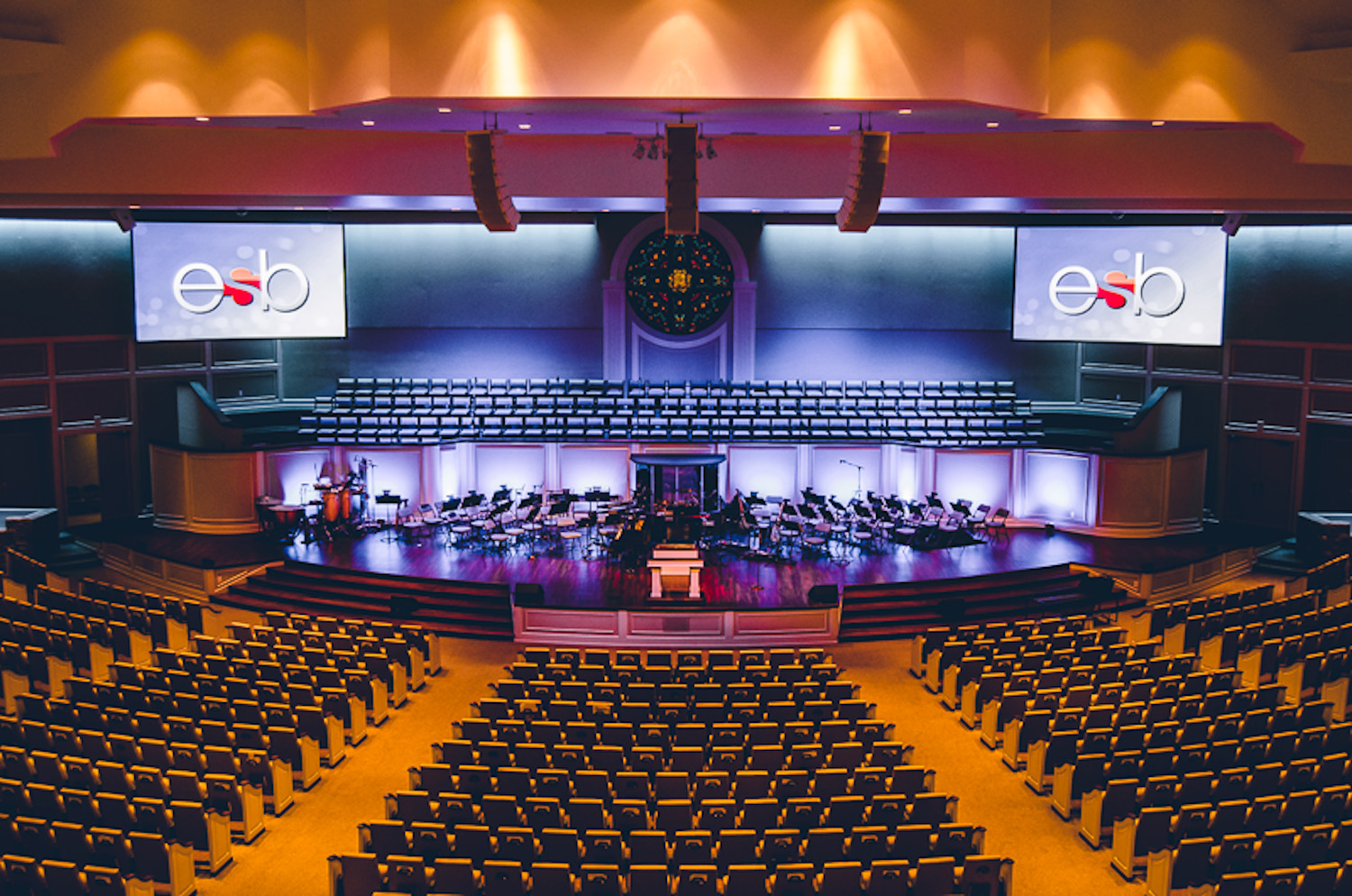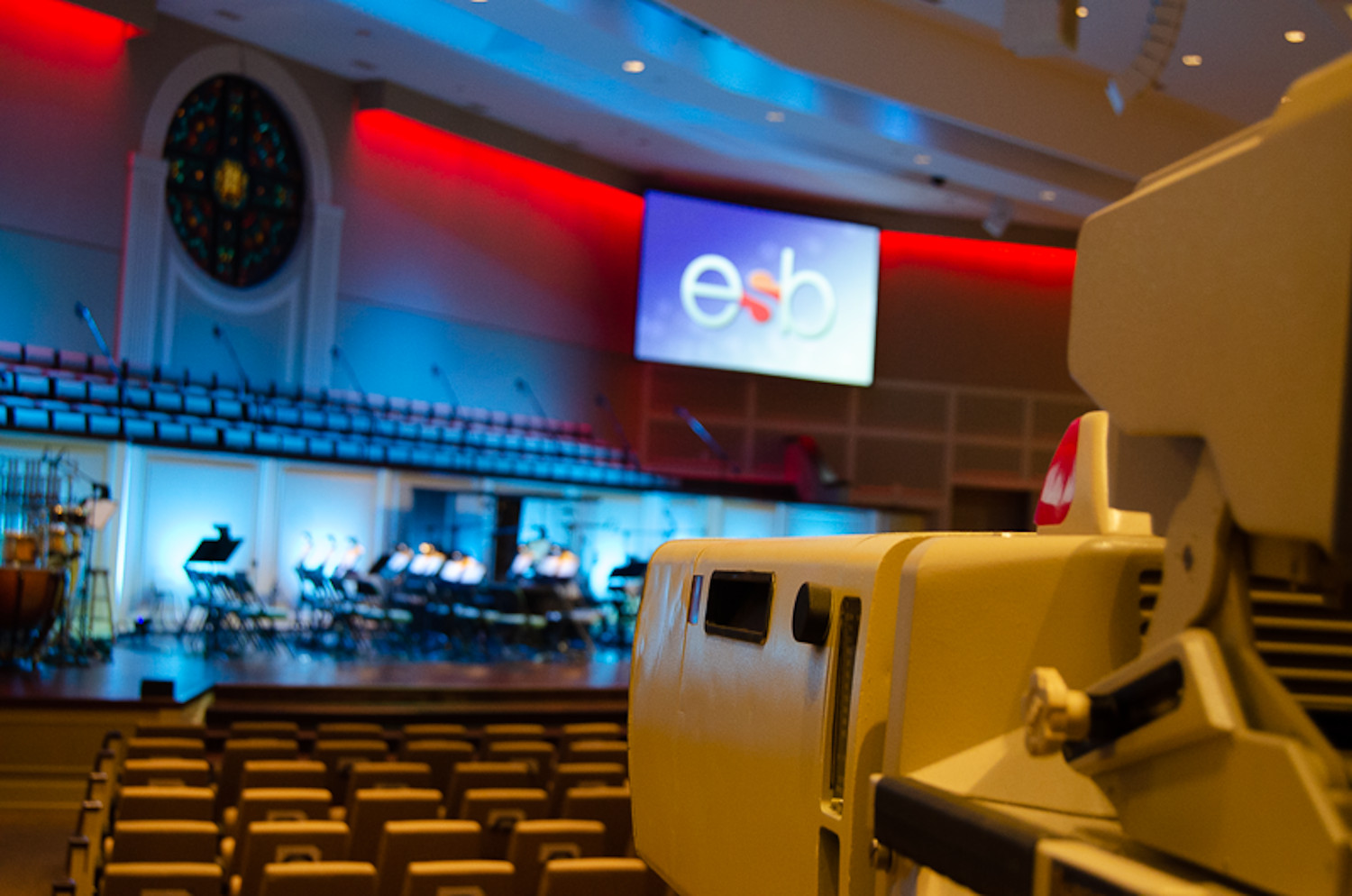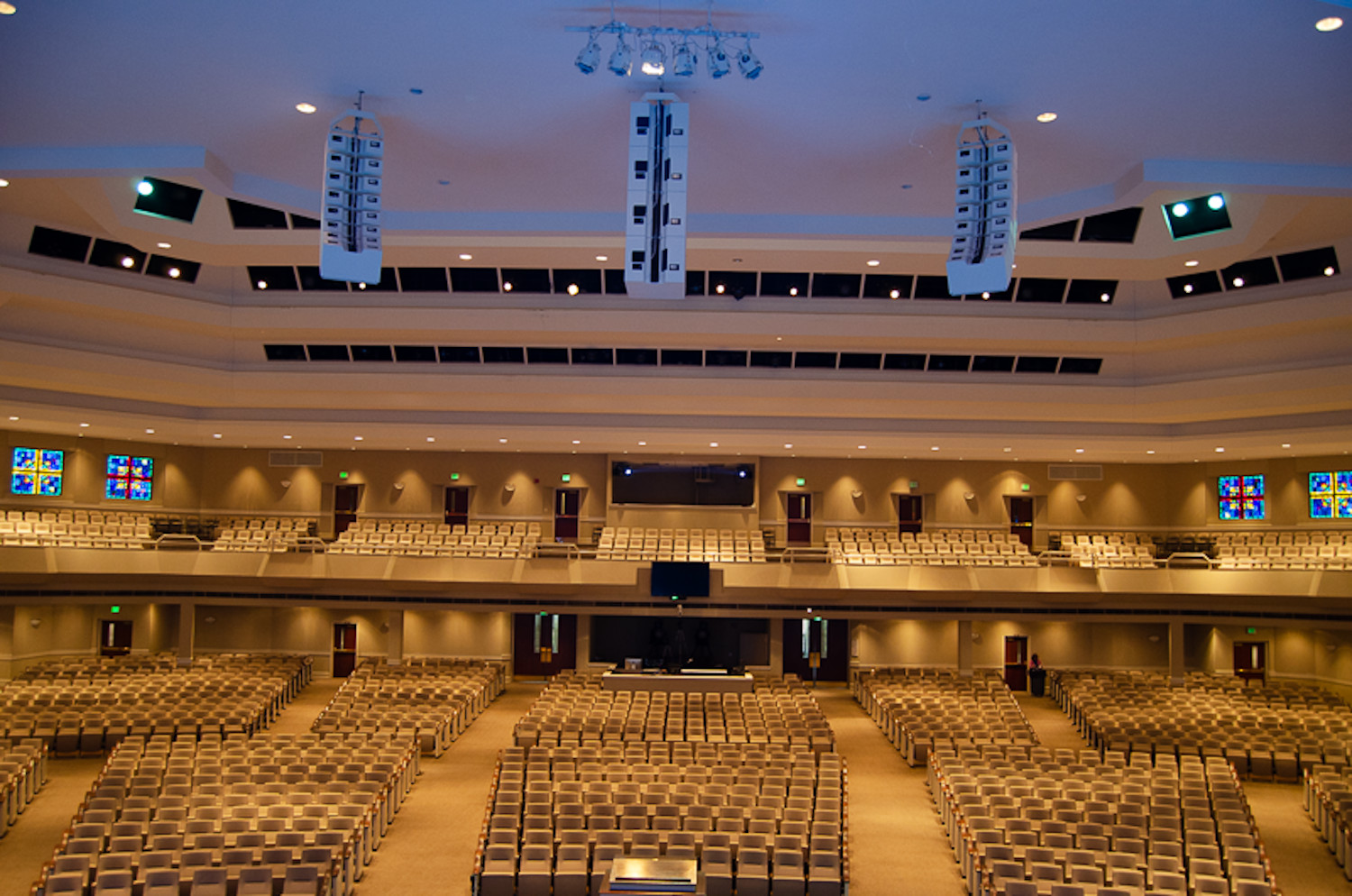Hunter Street Baptist Church establishes 12G and 4K-capable foundation.
The novel coronavirus (COVID-19) temporarily halted AV-integration projects across most verticals, with houses of worship (HoWs) being among the most affected. As luck would have it, the ESB Group of Alabama wrapped a large installation at a Birmingham AL-area church just as lockdowns took shape. Fortuitously, the key players had an unexpected ace in the hole, as the design included technologies to support livestreaming of worship services. Hunter Street Baptist Church is located in Hoover AL, in a busy suburban neighborhood outside of Alabama’s largest city. The church moved to a 2,000-seat worship center in 2000, and it purchased a used mobile production truck several years later to support its efforts to bring the message to the masses. That truck was gutted and the equipment was eventually used for an on-campus control room.
Although the technology was in fine shape at the time it was purchased, the SD-SDI video systems were already aging at that time. Today, the systems are considered fully antiquated in comparison to the formats and technical infrastructure that drive contemporary operations. Furthermore, the equipment was becoming harder to maintain. As an example, many of the boards in the circuit-based components were beginning to fail. Every Sunday, personnel would have to white-balance the cameras several times just to maintain the correct image color. Additionally, the image quality was not ideal for image magnification (IMAG) or livestreaming.
“This was simply a system that [had] reached end of life,” Patrick Sobers, Design Engineer for the ESB Group, said. “They had a very good SD-SDI system with highend cameras, but it was still an antiquated format with technical limits. They now have a full 1080p system with the ability to unlock 4K capability with just a few updates.”

Fiber Is The Future
The project required a nearly complete “rip and replace” to modernize the infrastructure. Although the layout and the furniture were retained, virtually everything else went through a wholesale change. That included a new control room, a new camera system in the worship center and a high-speed fiberoptic backbone to move video and audio throughout the facility.
“We retained the general ergonomics to simplify matters,” Sobers explained. “For example, we kept the layout of the shading area the same and just made some modifications to the openings. That allowed us to sink the new RCPs into the counter to create more efficient operating environments for the shaders.”
“We completely gutted the control room so we could start fresh,” Sobers added. “That meant removing a lot of five-wire and triax. In fact, we replaced all the existing triax with new fiber.”
The integration team installed 48 pairs of single-mode fiber between the control room and front of house (FOH), as well as 24 pairs of the same between the control room and a pre-existing audio room that houses most of the worship-center infrastructure. MultiDyne fiber-transport systems are used throughout the church for video, audio, data, genlock/sync and Ethernet transport.
“Single-mode fiber offers much greater value than triax in a modern AV infrastructure,” Sobers declared. “The single-mode fiber is all 12G-ready, which eliminates any bandwidth problems upfront. We also have the 12G transport capability built in with the MultiDyne systems between the cameras, the control room and the worship center.”
The ESB Group, in conjunction with the production team from Hunter Street, selected seven Sony cameras for the sanctuary, including four HDC-3100 camera systems and three BRC-X1000 pan–tilt–zoom (PTZ) cameras. For now, the cameras are set up to operate in 1080p, but they are upgradeable to 4K with a simple software update. Those cameras were matched, respectively, with four MultiDyne SMPTEHUT transceivers and three MultiDyne VB-3917 LightBrix fiber-transport products.
Two of the HDC-3100s are positioned permanently in the FOH booth, pointing dead center at the stage; the other two are positioned at the far left and right wings of the worship center. Two of the PTZs float from week to week to capture the orchestra from varied points of view, whereas the third retains a permanent position on the balcony’s edge.

“We have a 700-foot run from the HDC-3100s to the control room, and the SMPTE-HUT moves camera signals over fiber,” Sobers detailed. “These are simpler systems that we basically use to transport live video signals. The HUTs convert the signals, as required, as they move between the cameras and the CCUs [camera control units].”
The SMPTE HUT transceivers automatically paired to HDC3100s with a couple of simple dipswitch settings that were done at the factory. From there, it was as simple as rackmounting the HUT, connecting the fiber and powering the camera through the system.
“We like how the HUT allows us to inject power on the remote side of the camera position,” Sobers said. “That way, we don’t have to bus power that entire distance, and we can use dry fiber throughout the building. That makes it easy to patch, and [it] removes the need to establish a bunch of expensive legacy connectors everywhere. If anyone needs to make a new drop, we just add some inexpensive single-mode fiber and they move the camera to that position.”
The VB-3917 throw-down units provide more flexibility for the floating PTZ cameras, and, in addition to video, they carry all the control signals required for PTZ point-of-view (POV) systems. Sobers explained that they transport 12G from the camera and 3G video back to the camera positions. From there, the operators backfeed video to the sanctuary from the control room.
“The VB-3917 boxes move this entire complement of signals over 12G to an AJA KUMO 6464-12G router, which sends everything to a Ross Video Carbonite Ultra HD 2ME production switcher,” Sobers noted. “They have genlock back and forth, and, when those lights are active, we know there’s a video flowing. And we can also monitor all this through the connected openGear dashboard.”
Maintain Simple Connectivity

Sobers opted for the Ethernet feature on the VB-3917 to maintain simple connectivity with the control room. In the event of a network failure, no one is reliant on a switch to be enabled to maintain control.
“The control signals just come though the VB-3917 and then move back to the control room,” Sobers added. “There is a great deal of flexibility now for moving high-resolution video content and control data through the facility.”
The Carbonite system, from Ross Video, is one of the elements that Sobers referenced as being operational for 4K today, albeit with some minor updates. He explained, “They purchased the 4K license, so they can make those updates whenever they want. For now, they only needed 1080p HD capability [to be] ready to go.”
The Carbonite system includes four multiviewers, two of which are used at graphics stations in the worship center for FOH and the choir. Sobers added the latter is also a dedicated prompter position for choir confidence monitoring. A third multiviewer is used at the TV shading position, which also includes Marshall 24-inch 4K V-R241-K master confidence monitors for waveform/preview functions.
“We keep choir graphics fairly separate from the rest of the infrastructure, and [we] centralize that operation to an 80-inch Blackmagic Design SmartScope Duo monitor,” Sobers said.
The control room also features a new DiGiCo S21 48-channel audio mixer to in the back row of the control room, along with a graphics station running Renewed Vision ProPresenter 7 software and a workstation with Vimeo Livestream Studio software. The latter is used to transform computers into production control rooms for livestreams, and it allows the operator to input multiple feeds, graphics and master audio received from other sources in the control room.
The Studio 6 system has established a foundation for streaming direct to Facebook, Vimeo and YouTube. That’s especially important now, in light of the multimonth lockdowns that, to some extent, are still in place. Sobers added Blackmagic Design Ultra Studio 4K encoders for ingestion to the streaming network.
“They have an ISP [internet service provider] relationship in place to handle the video signal from that point, and there was no in-house network reconfiguration required,” Sobers confirmed. “Our work stops at the encoding stage, [with] the content-delivery experts [taking] care of things from there.”

What Lies Ahead
Some equipment from the previous system was retained, as it remained in line with Hunter Street’s evolving needs. That includes the existing IMAG system, composed of Da-Lite screens along with Barco RLM-W12 DLP projectors. The church continues to use its existing ProPresenter media and lyrics-presentation software.
“It’s ProPresenter all the way for them,” Sobers affirmed. “All three graphics positions—broadcast, [FOH] and choir—use ProPresenter 7. These stations all interface with Blackmagic Design Ultra Studio devices, and they take advantage of the new alpha channel built into the software for the broadcast feed.”
Lighting also was not modified, if only for the time being. “The church has a very good theatrical set already,” Sobers said. “Their next step is a transition to LED, which is a project we are entering the design stage on. We see that as the next major upgrade.”
He concluded, “The spirit of this design-and-integration project is really about being proactive on their behalf and helping them futureproof for the opportunities that lie ahead. By enabling 12G throughout the facility, establishing a robust fiber backbone and upgrading their streaming capabilities, Hunter Street Baptist Church is set up for high-quality in-house AV [and streaming] capabilities well into the future.”
To read more from Sound & Communications, click here.